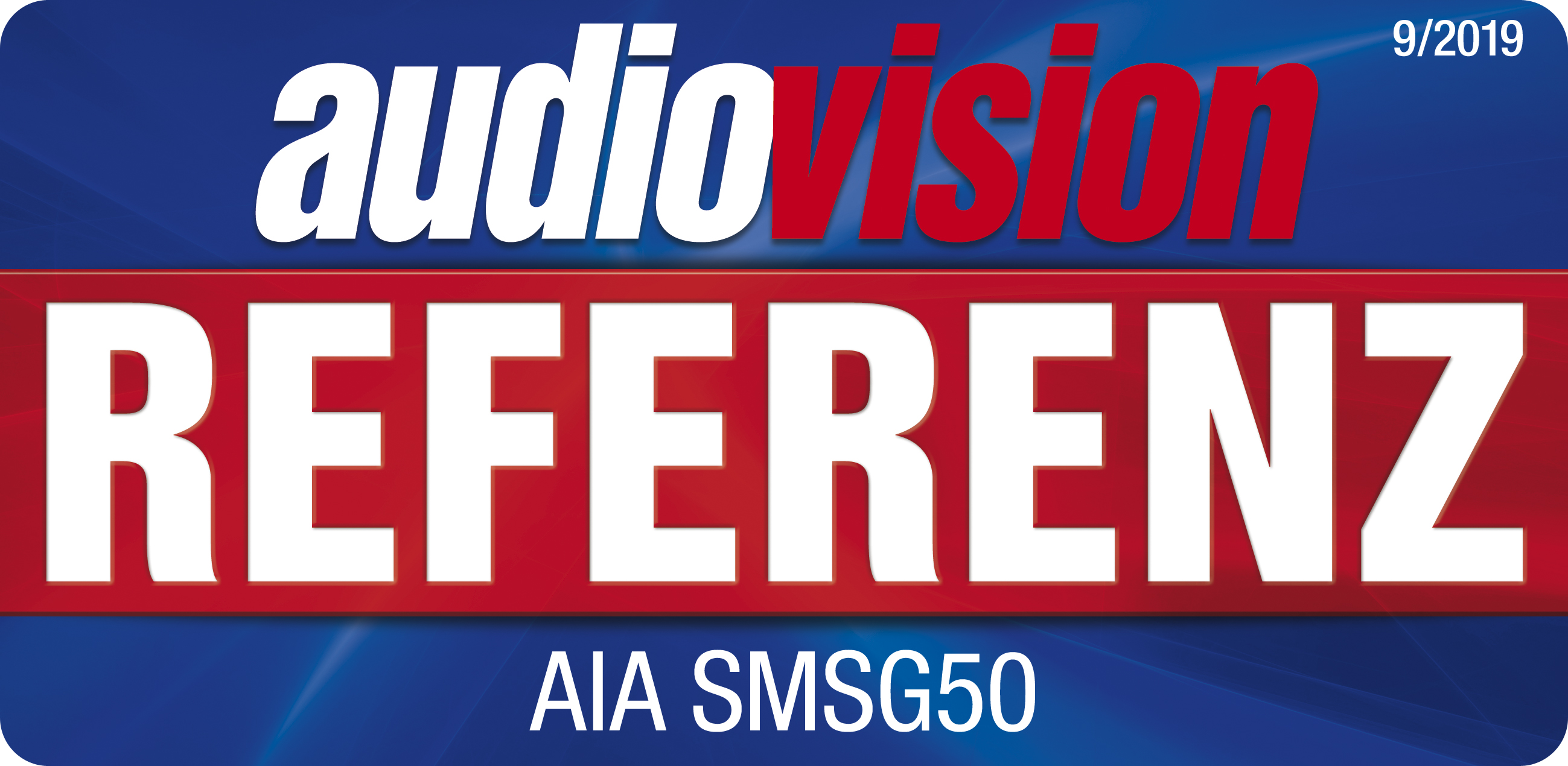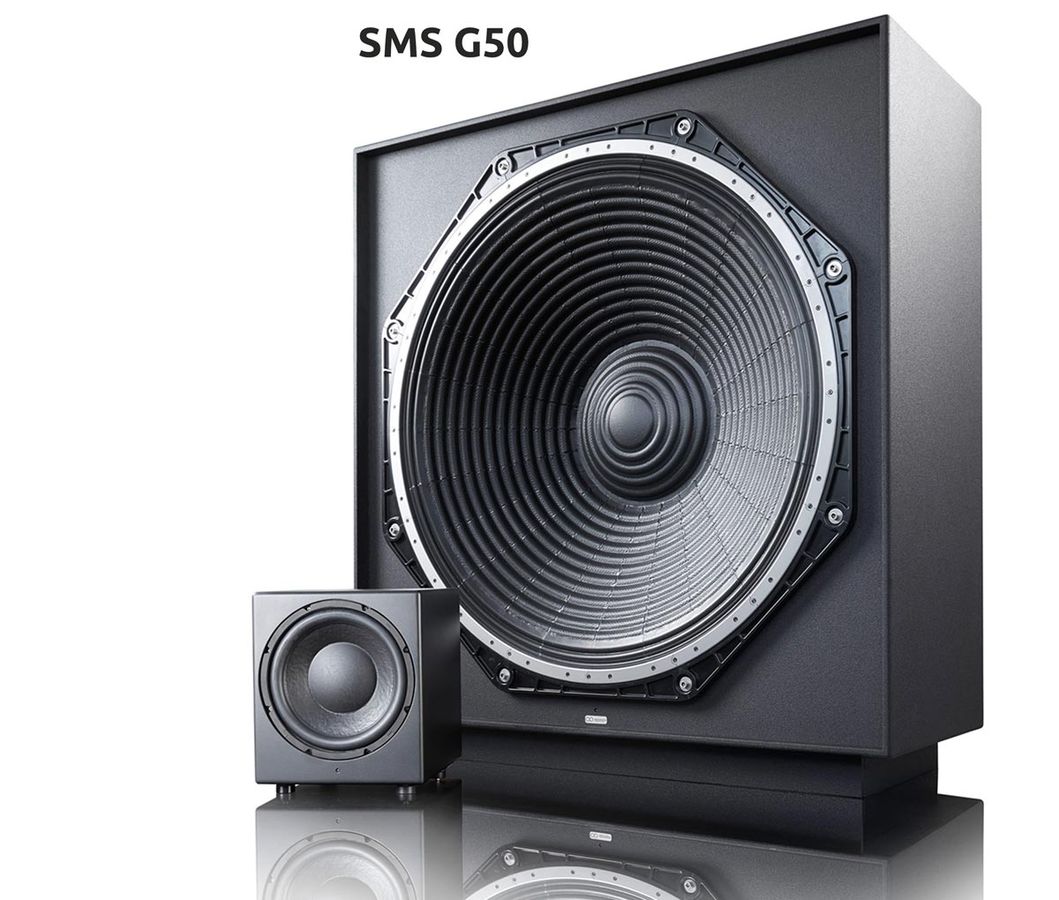AIA SMSG50
+ extremely low cut-off frequency
+ universally adjustable for system and room
+ extremely accurate sound with immense high level reserves
- not easy to adjust
Subwoofers should be as small and inconspicuous as possible so that the environmental appearance of the room is not affected too much. With the SMSG50, AIA from the Franconian city of Ansbach, Germany, is brushing against the grain: with its wardrobe-size dimensions, no significant other lets it enter her living room. It doesn't belong there either, but in a home theater instead. And in one that explores the boundaries of the feasible.
Technology
That such a – and yes, one may say it quietly – behemoth is considered necessary, is due to physical principles. Even with today's sophisticated driver technologies, here instead applies the well-known maxim that nothing can replace membrane area except even more membrane area.
Even drivers with a diameter of 38 or 45 centimeters reach the limits of their excursion capacities at less than 40 Hertz. Distortions in the double-digit percentage range are quite common here even at levels below 95 decibels – if they are reached at all.
The comparison with the truly not small SMSG15 makes it really clear how big the SMSG50 from AIA actually is. In standard finish it comes with a PU structure lacquer derived from the PA sector. However, AIA also offers a twelve-coat piano lacquer finish.
In order to solve this problem, one can only step up to a larger membrane area. And that's exactly what Stefan Köpf and his AIA team have pushed to the limit with the SMSG50: Its driver has a diameter of 127 centimeters, which is twenty times the area of a 45 centimeter unit. And that's not all: the 35 millimeters of maximum excursion are also considerably more than what conventional subwoofer drivers have to offer. The gigantic diaphragm is driven by a voice coil with a diameter of 34.5 centimeters, which is already more than the entire driver of a "normal" sub is measuring.
The enclosure with its 2,000 liter of volume is conceived as a sealed design. Actually, this still isn’t enough for the driver, so that its frequency response would already drop at about 60 Hertz without any kind of equalizing. This is what the SMSG50 has in common with most modern subwoofer designs. The universally applied antidote is the so-called equalization compensation, which means the raising of low frequencies. In order to be able to reproduce them even at high levels, a lot of amplifier power is required. This is ensured by the integrated switch-mode output stage with 6,000 watts of nominal power, while the equalization of the frequency response is done by the electronics already known from other AIA subwoofers. Two DSPs do not only handle this with ease, but also allow for a comprehensive room correction.
The rear connector panel of the AIA sub does not contain a control element, but only two XLR inputs and three Ethernet network connections. These are used, among other things, to connect a PC, which can be used to carry out the complete basic setting of the device using a special software program. More importantly, the subwoofer can also be fed with an audio signal via Ethernet using the AVB protocol, which was introduced in 2012 and specializes in audio and video transmission. The abbreviation AVB stands for Audio Video Bridging and describes a network protocol that controls audio and video signal streaming via Ethernet, which is quite common network technology. However, the emphasis was placed on giving audio and video signals priority over other network data because this is the only way to ensure that they arrive at the user without any interruptions and in sync.
The AIA sub accepts analogue signals via balanced input sockets. However, it can also be fed with sound signals via AVB using Ethernet technology.
Sound quality
We could not test a subwoofer with the dimensions and weight of the SMSG50 in our usual premises, transport and installation would have been too expensive. Therefore we packed our stuff and brought measuring equipment and software to the manufacturer in Ansbach. Of course, it very much helped that AIA had set up a home theater there in order to offer their own products a suitable environment. It features 28 channels, being able to process Dolby Atmos, Auro-3D and DTS, which are fed via AVB.
A final ascertainment of the maximum volume level was not possible because it simply exceeded the capacities of the measuring equipment. At 120 decibels both the measuring microphone and the room backed out – none of them could absorb a higher grade of subsonic energy. But, neither the power amplifier nor the driver had yet reached their limits.
The SMSG50 played as low as no other subwoofer we knew before: Its lower cut-off frequency with deactivated low-pass filter was 6.6 hertz, with the low-pass cut-off frequency set at 30 Hertz even 6.2 hertz. By the way, 30 hertz had been also selected as cut-off frequency in the AIA demo room, while from 30 to 80 Hertz a total of four SMGS15 (reviewed in 8-2017) are used. All frequencies above that are reproduced by coaxial one-point sources also developed by AIA.
Anyone who expected from the SMSG50 the ultimate punch in lowest bass right from the start will surely be disappointed when listening to music such as "Listen Up!" by Omar Hakin: Even at a higher level there is no excessive bloodcurdling subsonic revelry. Instead, there is an extremely contoured, infinitely precise and ultra-deep bass reproduction, which follows up every increase in volume with ultimate ease and lets even extreme levels appear like an afternoon stroll. This bass comes up with a contour, precision and blackness that has never been heard in our tests before. This also perceptibly augments the spatial imaging in such a way that you must have heard it in order to believe it.
However, to tease the beast out of the giant subwoofer you must pass on to action movies: Whether it's in the tow truck scene of "Terminator – Salvation" where it gets the motorbike robots crashing thunderously into the wrecked cars at the roadside or in the moment when the drone under the bridge gets your stomach walls shaking, this subwoofer shows a vehemence and a mercilessness that can already highly cause discomfort to sensitive natures. It's perfectly conceivable that its operation could bring the plaster to trickle off the ceiling when played at too high volumes – and it doesn’t stop here.
Reasonably applied, however, it offers a hitherto unknown dimension of bass reproduction, as the scene with the bombarded skyscraper carcass in "The Expendables 3" clearly demonstrates: The pressure waves of the tank’s cannon shots can be felt with the whole body, the explosions find their way directly and extremely credibly into the pit of your stomach. There's really no subwoofer sound to be heard, everything sounds like real and lets the audience immerse even deeper into the home theater illusion.
Mino
AV conclusion
A full score is a must for a subwoofer costing a lot of money – but with the SMSG50 from AIA the expense is completely justified, as it by far outpaces all other subs in depth, accuracy and power handling.
The AIA sub offers detailed adjustment options via the UNOS Creator software. The equalizer frequencies are freely configurable in frequency, level and quality.
AIA SMSG50
Equipment
Dimensions (HxWxD) 185 x 180 x 60 cm
Weight more than 200 kg
Functional principle sealed
Internal amplifier power (as specified) 6,000 watts
Chassis diameter 1 x 1,270 mm (50 inch)
Connections
Audio inputs XLR and Ethernet sockets
Audio outputs XLR and Ethernet sockets
Features
High pass filter yes
Low pass filter 20 to 20,000 Hz
Phase setting adjustable
Equipment very good
VALUATION
SOUND QUALITY 5.1 MULTICHANNEL 80 / 80
Sub minimal / medium
/ maximal crossover frequency
Cleanly tuned, fine adjustable low pass filter. The frequency response of the SMGS50 can be
perfectly linearized with the help of the integrated DSPs.
Lower cut-off frequency 6.2 / 6.6 Hz (min./max. low pass) 25 / 25
Maximum sound pressure 120 / 120 dB (min./max. low pass) 25 / 25
Listening test ambient noise very good 10 / 10
Listening test bass depth very good 10 / 10
Listening test accuracy very good 10 / 10
EQUIPMENT very good 10 / 10
MATERIAL & WORKMANSHIP very good 10 / 10
AV rating very good 100 out of 100
REFERENCE CLASS
„FACING THE BOUNDARIES OF THE FEASIBLE“
What caused AIA to create such a huge and expensive subwoofer?
The SMSG50 is designed as both a spearhead in technology and a flagship. With it, we want to explore the boundaries of the feasible. The combination of pressure and speed with which the SMSG50 transmits even the lowest tones below 10 Hz is fascinating.
Why did you choose AVB as your digital playback protocol? Doesn't that make the AIA subwoofers incompatible with the rest of the home theater market?
First of all, all our subs offer analog inputs, so they're easy to control also in the traditional way. Via the AVB Ethernet network, all audio data is transmitted in high resolution and in absolute time-coherency. All AVB devices play back the audio data at exactly the same time with an accuracy of 0.0000000030 seconds. For comparison: A sample at 96 kHz is about 0.00000001 seconds long. AVB guarantees a synchronicity, which is so important for timing, even if different cable lengths are used in parallel. Due to its great advantages, the world's three largest manufacturers of commercial audio systems now also use the AVB network technology.
Isn't there the risk of a health hazard when using the SMSG50 at full level? After all, you state that it is capable of delivering 140 decibels of sound pressure.
You're right, too high volume levels over a longer period are really not advisable with the SMSG50. On the one hand because of the possible consequences for health, as this extreme sound pressure at such low frequencies can permanently injure not only the hearing ability but also other organs. Moreover, it can also damage the building in which the subwoofer is operated. Therefore the buyers of this subwoofer are made attentive in detail to the possible risks and must sign an appropriate disclaimer.
Which clientele are you targeting with such an expensive sub, that furthermore requires a time-consuming set-up?
Commonly, there is a certain circle of users in the home theater sector that constantly strives for the very best and the highest quality in everything. For this particular group of customers the price is of secondary importance. The requirement of space is also some kind of a smaller obstacle that can be overcome. However, the price of the SMSG50 is rather low in relation to its performance. Because the SMSG50 moves as much air as forty-two 18-inch subwoofers. There are many large home theaters, especially in the USA, where sixteen or more 18-inch subwoofers are installed. The price of the SMSG50 corresponds approximately to the price of ten to twelve active high-quality 18-inch subwoofers.
The SMSG50 therefore requires less space, is much faster and more accurate, reaches 12 to 15 Hz lower down, plays louder and with more authority, and ultimately moves much more air (4 times as much).
Stefan Köpf in front of the man-high subwoofer AIA SMSG50. We asked the AIA associate some questions about the flagship product of the company from the Franconian city of Ansbach.



